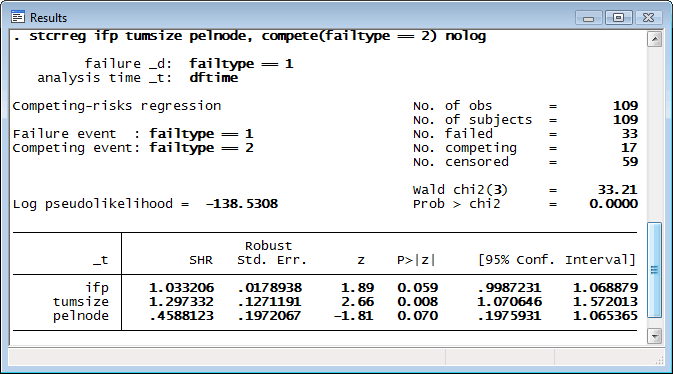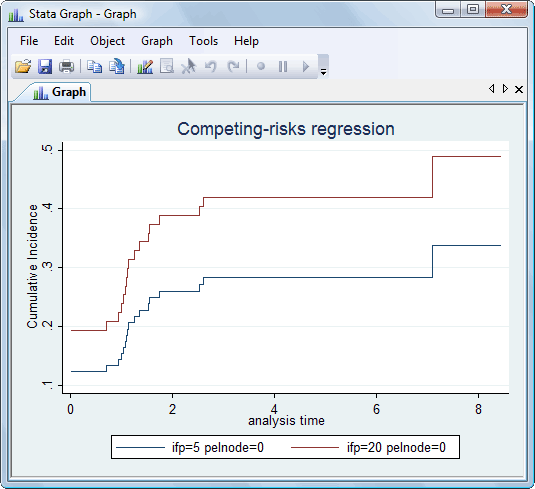

2025 Stata Economics Virtual Symposium • 6 November
Competing-risks regression was introduced in Stata 11.
|
| Order |
Competing-risks survival regression provides a useful alternative to Cox regression in the presence of one or more competing risks. For example, say that you are studying the time from initial treatment for cancer to recurrence of cancer in relation to the type of treatment administered and demographic factors. Death is a competing event: the person under treatment may die, impeding the occurence of the event of interest, recurrence of cancer. Unlike censoring, which merely obstructs you from viewing the event, a competing event prevents the event of interest from occurring altogether, and your analysis should adjust accordingly.
Stata’s new stcrreg command implements competing-risks regression based on Fine and Gray’s proportional subhazards model. In Cox regression, you focus on the survivor function, which indicates the probability of surviving beyond a given time. In competing-risks regression, you instead focus on the cumulative incidence function, which indicates the probability of the event of interest happening before a given time. Competing-risks regression is semiparametric in that the baseline subhazard of the event of interest is left unspecified, and the effects of covariates are assumed to be proportional. Time-varying covariates and coefficients are allowed.
Here we fit a model for cervical cancer patients, where the event of interest is a relapse of cancer located in the pelvis. A competing event is the occurrence of cancer in another part of the body.

Stata’s stcurve command allows us to examine the cumulative incidence function:
. stcurve, cif at1(ifp=5 pelnode=0) at2(ifp=20 pelnode=0)

For a complete list of what's new in survival analysis, click here.
Explore more about competing risks regression in Stata.
Learn
Free webinars
NetCourses
Classroom and web training
Organizational training
Video tutorials
Third-party courses
Web resources
Teaching with Stata
© Copyright 1996–2025 StataCorp LLC. All rights reserved.
×
We use cookies to ensure that we give you the best experience on our website—to enhance site navigation, to analyze usage, and to assist in our marketing efforts. By continuing to use our site, you consent to the storing of cookies on your device and agree to delivery of content, including web fonts and JavaScript, from third party web services.
Cookie Settings
Last updated: 16 November 2022
StataCorp LLC (StataCorp) strives to provide our users with exceptional products and services. To do so, we must collect personal information from you. This information is necessary to conduct business with our existing and potential customers. We collect and use this information only where we may legally do so. This policy explains what personal information we collect, how we use it, and what rights you have to that information.
These cookies are essential for our website to function and do not store any personally identifiable information. These cookies cannot be disabled.
This website uses cookies to provide you with a better user experience. A cookie is a small piece of data our website stores on a site visitor's hard drive and accesses each time you visit so we can improve your access to our site, better understand how you use our site, and serve you content that may be of interest to you. For instance, we store a cookie when you log in to our shopping cart so that we can maintain your shopping cart should you not complete checkout. These cookies do not directly store your personal information, but they do support the ability to uniquely identify your internet browser and device.
Please note: Clearing your browser cookies at any time will undo preferences saved here. The option selected here will apply only to the device you are currently using.